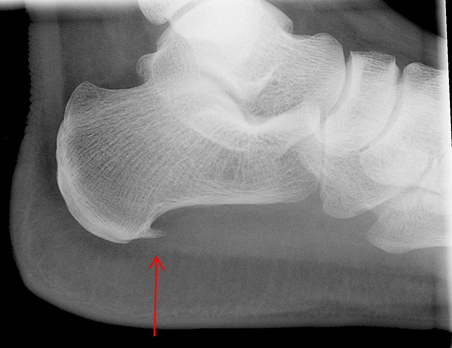Plantar fasciitis is the most common cause of pain on the bottom of the heel.
The plantar fascia is a strong band of connective tissue that stretches from the heel to the ball of the foot, supporting the arch of the foot.
The plantar fascia is designed to absorb the body’s weight when standing, walking and running. But, sometimes, too much pressure damages or tears the tissues. The body's natural response to injury is inflammation, which results in the heel pain and stiffness of plantar fasciitis.
Plantar fasciitis occurs when this fascia becomes irritated and inflamed due to overuse. This leads to pain on the bottom of the foot near the heel.
People may experience pain with the first few steps after getting out of bed or after sitting for prolonged periods. The pain usually subsides after a few minutes of walking. The pain tends to be greater after activity, not during activity.
Most cases plantar fasciitis arise without an identifiable cuse. There are, however, risk factors that can make someone more likely to develop plantar fasciitis. These include:
- Tight calf muscles that make it difficult to bring your toes up toward your shin
- Being overweight or obese
- High arches
- Sports or activities that lead to repeated impact to the foot, such as running.
Treatment Options for Plantar Fasciitis
Your doctor will recommend a treatment plan based on the severity of symptoms, responses to past treatments, your medical history and personal preferences.
It is important to note that the majority of people with plantar fasciitis will improve with simple non-surgical approaches.
- Rest. Decrease or stop the activities that make the pain. You may need to stop athletic activities where your feet pound on hard surfaces, such as running
- Ice. Rolling your foot over a cold water bottle or ice for 20 minutes, 3-4 times per day is effective.
- NSAIDs (Nonsteroidal anti-inflammatory drugs) Over-the-counter anti-inflammatory medication, such as ibuprofen or naproxen, can reduce pain and swelling. Using the medication for more than 1 month should be reviewed with your doctor.
- Exercise. Plantar fasciitis is aggravated by tight muscles in your feet and calves. Stretch your calves and plantar fascia to relieve the pain that comes with this condition.
- Corticosteroid injections. Corticosteroid (cortisone) is a powerful anti-inflammatory medication that be injected into the plantar fascia to reduce inflammation and pain. There is a limit to the number of times corticosteroids injections can be administered. Multiple steroid injections increase the risk of the plantar fascia becoming weak and even rupturing.
- Supportive shoes and orthotics. Wear shoes with thick soles and extra cushioning to reduce pain when standing or walking. Soft silicone heel pads are inexpensive and work by elevating and cushioning your heel. Pre-made or custom orthotics (shoe inserts) can also be helpful.
- Night splints. Most people sleep with their feet pointed down. This relaxes the plantar fascia and is one of the reasons for morning heel pain. A night splint stretches the plantar fascia while you sleep. Although it can be difficult to sleep with, a night splint is very effective and does not have to be used once the pain is gone.
- Physical therapy. Your doctor may suggest that you work with a physical therapist on an exercise program that focuses on stretching your calf muscles and plantar fascia.
Surgical Treatments for Plantar Fasciitis
Most patients have good results from surgery. However, because surgery can result in chronic pain and dissatisfaction, it is recommended only after all nonsurgical measures have been exhausted.
Surgical treatments for plantar fasciitis include:
- Gastrocnemius recession.
- Plantar fascia release.
Plantar Fasciitis Prevention
- Always warm up well and stretch before athletic activity
- Wear good, supportive shoes for your athletic activities
- Keep the muscles of your feet and ankles strong to support your arch
- Don’t try running to lose weight after a rapid weight gain
- Walk first, and stretch the muscles of the foot and calf to help condition your body before running
- Avoid activities that cause pain in your heel
Source: Vivacare
Last updated : 12/1/2022